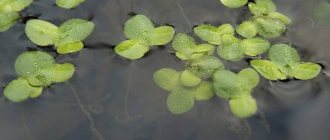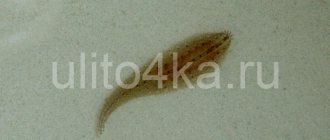The leaf blades are shaped like hearts; at the base of the leaf there is a deep and wide cutout. The color of the leaves changes depending on the light and the concentration of nutrients in the water. Under good maintenance conditions, you can achieve a red color on the leaf blades.
Some aquarists note that young leaves of Phyllanthus buoyantus are predominantly green, and red shades can only be observed on older leaves.
The leaf diameter rarely exceeds 5 cm. If the plant is well cared for, you can get flowers about 2 mm in size and small round fruits up to 2-3 mm in diameter. The leaf blades are arranged on the stem in 2 rows.
The upper side of the leaf is convex and has a velvety surface due to the large number of hairs. From the place where the leaf blade is attached to the stem, noticeable veins diverge radially.
Medicinal properties and uses
According to some claims, Phyllanthus niruri may have several beneficial effects on various body systems. However, only a small amount of research has been conducted to support these claims.
Stones in the kidneys
Phyllanthus niruri is best known as a potential cure for kidney stones, which is how the plant got its name “stone crusher.”
The plant is alkaline, so it can help prevent the formation of kidney stones. It is a less expensive, over-the-counter alternative to prescription potassium citrate, an alkalinizing agent commonly used to prevent kidney stones from forming in acidic environments. This remedy may also help you urinate more ().
One study of 56 people with kidney stones who took 4.5 grams of Phyllanthus niruri daily found that kidney stones decreased in size and number in about two-thirds of the participants ().
Moreover, other small human studies have shown some benefit from taking Phyllanthus niruri for kidney stones ().
Stomach ulcer
Test-tube studies have shown that Phyllanthus niruri extract can kill the bacterium that causes stomach ulcers, Helicobacter pylori. However, this does not necessarily mean that oral supplements are effective against stomach ulcers in humans (, ).
Test tube studies like these typically involve the use of highly concentrated extracts applied directly to bacterial cells, but this is not how oral Phyllanthus niruri supplements will work.
High blood sugar
In animal studies, the antioxidants present in Phyllanthus niruri were able to improve fasting blood sugar levels, which may help regulate blood sugar levels (, ).
However, this does not necessarily mean that Phyllanthus niruri will have the same effect on humans.
More research is needed to understand the effects of this herbal remedy on blood sugar levels in humans.
Gallstones
For the same reason that Phyllanthus niruri can help with kidney stones, the alkalizing properties of this plant can also help prevent the formation of gallstones. It is used in some traditional medicine as a medicine for gallstones ().
However, there is no scientific evidence to support the use of Phyllanthus niruri for gallstones.
Gout
When high levels of uric acid accumulate in the blood, gout flare-ups can occur. Phyllanthus niruri may help balance these levels and prevent gout attacks.
Some animal studies have shown a decrease in uric acid levels in animals supplemented with Phyllanthus niruri (Phyllanthus niruri).
Liver disease
Thanks to the antioxidants contained in Phyllanthus niruri, its use may improve liver function and help protect the liver from cellular damage caused by free radicals - unstable compounds that can cause damage when they accumulate in your body in large quantities ().
The plant also appears to be useful for treating hepatitis B, an inflammatory viral infection of the liver, at least in animal and test tube studies ().
Because several other plants in the Phyllanthus genus exhibit potent antiviral activity against hepatitis B—potentially rivaling that of the antiviral drug interferon—researchers speculate that Phyllanthus niruri may have similar effects ().
However, most of this research has been done in animal or test tube studies. More human studies are needed to evaluate the effects of Phyllanthus niruri on liver health.
High blood pressure
Some animal studies suggest that Phyllanthus niruri may help relax blood vessels, which may lead to lower blood pressure ().
However, one human study noted a slight increase in blood pressure in people taking this herbal remedy. More research in humans is needed to better understand how Phyllanthus niruri affects blood pressure.
It is important to note that most of the existing research on the medicinal properties of Phyllanthus niruri has been conducted on animals or in test tubes using highly concentrated extracts.
Although there is little evidence to support the use of Phyllanthus niruri for kidney stones in humans, larger, more rigorous human studies are needed to determine whether this remedy actually has any beneficial effects.
Phyllanthus emblica
This is a tall tree that can grow up to 30 meters. The homeland of the logo is India, but it can be found in many Asian countries, for example, China, Thailand and Malaysia. All parts of the tree are used for medicinal purposes - bark, seeds, flowers and fruits. The latter contain a huge amount of useful vitamins and microelements, as well as proteins, fats and carbohydrates. The berries are distinguished by their juicy pulp and astringent taste with a slight sourness.
Phyllanthus emblica has the following healing properties:
- restores intestinal microflora;
- helps maintain proper functioning of the gastrointestinal tract;
- removes toxins from the body;
- reduces the risk of developing malignant tumors;
- restores the health of the oral cavity and gums;
- helps raise hemoglobin levels;
- normalizes the condition of people with type 2 diabetes;
- has a beneficial effect on visual acuity;
- helps maintain youth;
- promotes the restoration of liver cells;
- reduces the risk of developing atherosclerosis.
In addition to the above, emblica has pronounced antimicrobial and anti-inflammatory properties. Due to this, preparations based on this plant can be used for the treatment and prevention of skin diseases.
Side effects and contraindications
One human study reported some side effects of Phyllanthus niruri supplements, including:
- abdominal pain
- painful urination
- blood in urine
- nausea
Abdominal pain was by far the most common side effect, with others much less commonly reported ().
Phyllanthus niruri may also lower blood sugar and blood pressure levels, so if you are taking medications that lower blood pressure or blood sugar levels, it should be used with caution ().
Dosage and how to take
In one human study that showed improvement in kidney stones, the daily dose was 4.5 grams of powdered Phyllanthus niruri for 12 weeks ().
Phyllanthus niruri tablets or capsules contain 500 to 1600 mg of the plant per dose, and liquid extracts contain a similar amount.
It is difficult to say how much of this remedy you can get from tea, since the amount of active substances present in tea depends on the temperature of the water and how long the tea is brewed.
Phyllanthus niruri can be taken with or without food.
There have been no studies done regarding the long-term effects of Phyllanthus niruri, so it may be wise to limit the time you take the supplement to 12 weeks or less, the duration that has been studied in humans ().
Growing and care
Phyllanthus fluitans is quite demanding when it comes to growing conditions, so growing it can be difficult for a beginner. An experienced aquarist will be pleased with the plant with its rich red leaves. Floating phyllanthus will help create diffused lighting, which is necessary for some species of fish and aquatic plants.
This representative of the aquatic flora must be kept in medium or large open aquariums. In small containers it will be too crowded. Some owners of Phyllanthus fluitans prefer to plant it in humid greenhouses or paludariums.
Water parameters for ideal maintenance
As experts note, the recommended values of hydrochemical indicators depend on the level of lighting in the aquarium. Let's consider the recommended values in the presence of moderate and strong luminous flux.
When lighting at medium intensity, the following indicators must be maintained:
- temperature - 18-30ºС;
- hardness - 1-8 German degrees;
- acid-base balance - 5-6.
If the plant is supplied with a large amount of light, the permissible values change:
- temperature - 21-30ºС;
- hardness - from 8 to 14 German degrees, possibly even higher;
- acid-base balance - 5-7.
When adjusting the filter, it is important not to create a strong current. Floating phyllanthus prefers bodies of water with slow water flow.
Lighting requirements
As the owners of phyllanthus floatus note, the decorative properties of the plant are best revealed in the presence of bright lighting.
It is recommended to use fluorescent lamps with a power of 0.8 W/l. Phyllanthus fluitans is very light-loving. As noted above, it is necessary to determine in advance how much light will enter the aquarium, and at the same time adjust the hydrochemical parameters.
Demanding requirements for soil and nutrient substrate
Phyllanthus fluitans, although it has a developed root system, is a floating plant that does not need nutritious soil. In this matter, you need to focus on other plants in the aquarium. Let's consider two options:
- Green “neighbors” planted in the ground have powerful root systems. In this case, you can use a simple soil of sand, gravel or pebbles, and feed the tapeworms using tableted fertilizers.
- Other plants in the aquarium require a nutrient substrate. For example, solid fertilizers can damage the root system, or there is not enough liquid fertilizer. In this case, it is necessary to select soils that will not greatly affect the hydrochemical parameters. Phyllanthus buoyantus is quite sensitive to them.
Requirement for fertilizers
When growing Phyllanthus fluitans, it is necessary to add a lot of iron-containing fertilizers. The higher the concentration of this microelement, the greater the chance of getting beautiful leaves of rich red color. It is advisable to use liquid fertilizers with iron chelates. In this form, the necessary element is better absorbed by plants.
The following fertilizers are most popular among aquarists:
- Tetra Plant Flora Pride Red is a liquid food for red aquarium plants. In addition to large amounts of iron, it contains potassium and manganese. The fertilizer is absorbed evenly through the leaves, helping to maintain the rich red color of the leaves. Does not contain phosphates and nitrates.
- JBL Ferropol 24 - this fertilizer must be added daily. It helps maintain the bright color of the leaves, quickly dissolves in water, and is easily absorbed by aquatic plants.
- Florastim Fe is a liquid fertilizer with chelated ferrous iron and a high content of microelements necessary for the good growth of aquarium plants.
The plant does not have a strong need for carbon dioxide, but as a preventive measure and to maintain healthy growth, carbon dioxide can be added at a concentration of 3-5 mg/l.
Interactions
Phyllanthus niruri has the potential to interact with several medications, including:
- Lithium . Phyllanthus niruri may cause you to urinate more, which can affect how your body eliminates lithium ().
- Medicines to lower blood pressure . The plant may lower your blood pressure, which can potentially lead to lower blood pressure levels, especially in people who are already taking blood pressure-lowering medications ().
- Medicines to lower blood sugar levels . Phyllanthus niruri may lower blood sugar levels. If you are already taking insulin or other drugs that lower your blood sugar, this can lead to dangerously low levels known as hypoglycemia ().
- Blood thinners . Phyllanthus niruri may inhibit blood clotting, which can lead to serious complications in people taking blood thinning medications ().
Use in Certain Populations
Because little is known about Phyllanthus niruri, you should consult a physician before giving the supplement to children or adolescents.
People with type 1 and type 2 diabetes should also use this supplement with caution as it may lower blood sugar levels. In people who are already taking insulin or other drugs that lower blood sugar, taking it can lead to hypoglycemia ().
Because this remedy may affect kidney function, people with chronic kidney disease or other kidney problems should consult a doctor before using Phyllanthus niruri.
Contraindications
Despite the huge list of beneficial properties, Phyllanthus has a number of contraindications. The following groups of people should refrain from taking drugs based on it:
- women trying to get pregnant;
- persons with heart disease;
- people with individual intolerance;
- for allergy sufferers.
Phyllanthus is one of the most beneficial plants of Ayurveda. With proper and dosed use, you can not only get rid of a number of diseases, but also increase the effectiveness of the main therapy.
Alternatives
For kidney stones, you may want to consider some alternatives to Phyllanthus niruri, including other alkalizing agents such as sodium bicarbonate or potassium citrate. For kidney stones, potassium citrate is the most commonly used drug and is available over-the-counter or by prescription (,).
Because there is very little evidence of the effectiveness of this herbal remedy, if you have any health problems that you think Phyllanthus niruri might help with, you should consult your doctor.











